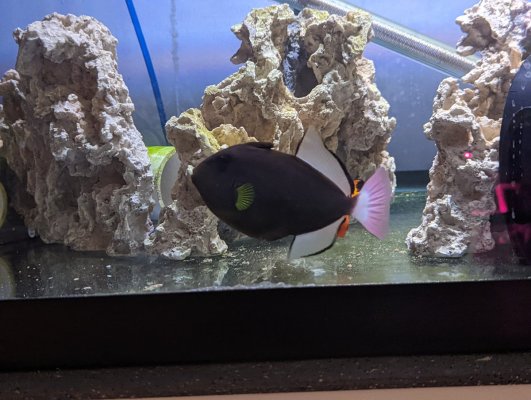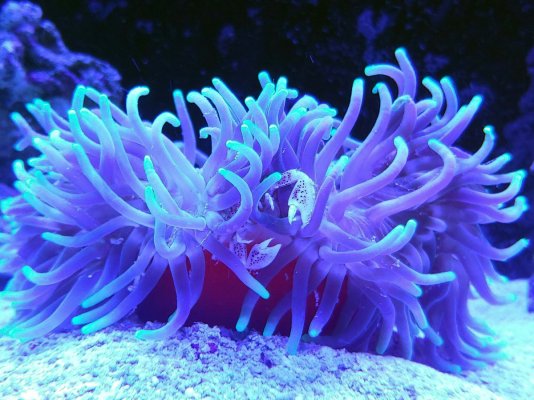No reason for a fish to be to cool! Beautiful fish
Navigation
Install the app
How to install the app on iOS
Follow along with the video below to see how to install our site as a web app on your home screen.
Note: This feature may not be available in some browsers.
More options
You are using an out of date browser. It may not display this or other websites correctly.
You should upgrade or use an alternative browser.
You should upgrade or use an alternative browser.
my new baby... AKA The Café
- Monster Build
- Thread starter fishguy242
- Start date
- Tagged users None
Beautiful
There are 2, I need more porcelain crabs.Beautiful
Me tooThere are 2, I need more porcelain crabs.
There are 2, I need more porcelain crabs.
Me too
Engineer goby food for me.
Crabs may or may not survive the wrasse. He's been swimming circles over the lta. I didn't buy the crabs, they were hiding under the skirt when the lta got bagged. I'm hoping the wrasse stays away.Engineer goby food for me.
Starting to see some specks of Corraline on the ugly algae covered rock  Soon we will have all purple rock instead of the Frankenstein'd rockwork
Soon we will have all purple rock instead of the Frankenstein'd rockwork
Starting to see some specks of Corraline on the ugly algae covered rockSoon we will have all purple rock instead of the Frankenstein'd rockwork
Be careful what you wish for, coraline will seal your live rock so it can't function, I ran at least 6 tuxedo urchins a few years ago and it took a year or so to get the rock back "live".
I have NEVER Considered the fact that it is actually growing and covering the pores.Be careful what you wish for, coraline will seal your live rock so it can't function, I ran at least 6 tuxedo urchins a few years ago and it took a year or so to get the rock back "live".
Wouldn't this only be an issue on the light facing side? Bottom, back, under, and inside the rocks will still be free and clear I would think.
I have NEVER Considered the fact that it is actually growing and covering the pores.
Wouldn't this only be an issue on the light facing side? Bottom, back, under, and inside the rocks will still be free and clear I would think.
Serious, think about it, it will grow anywhere with some light and is like a varnish on your rock, let the rock breathe.
Edit, anyone with coraline on frags, zoas will hate it and sps use more energy killing it before they base out.
I may have been a bit stony when I read this but I heard WWC cures their dry rock for about 6months in a black out set up. To help burn off the unwanted uglies and get coralline started. I’m guessing there’s types of non photosynthetic coraline? In that case they would cover those areas.Wouldn't this only be an issue on the light facing side? Bottom, back, under, and inside the rocks will still be free and clear I would think.
Maybe the bacteria can still do it’s thang under all that coraline. I think the urchins combing it back, to repeat the cycle is a good move. I wake up to a different white patch of rock work every morning from the single urchin I have. It’s a bit funny seeing where he was the night before, reminds me of a snail trail.
I'm not familiar with non-photosynthetic Coraline.I may have been a bit stony when I read this but I heard WWC cures their dry rock for about 6months in a black out set up. To help burn off the unwanted uglies and get coralline started. I’m guessing there’s types of non photosynthetic coraline? In that case they would cover those areas.
Maybe the bacteria can still do it’s thang under all that coraline. I think the urchins combing it back, to repeat the cycle is a good move. I wake up to a different white patch of rock work every morning from the single urchin I have. It’s a bit funny seeing where he was the night before, reminds me of a snail trail.
Speaking strictly from a surface area point of view, I only get Coraline on areas touched by direct light. It doesn't wrap around my frag rack pipes to the bottom, It doesn't grow in the shade of leathers. There's in fact a pretty distinct line that I can see where the LG has attempted to move forward but stalled out and died back. While I'm sure there is nps Coraline, I don't think it is as prevalent in my tank at least.
Sticking with the discussion of surface area, very little of our bacterial colonization surface is represented by what the light touches / what we can See (have bumped heads with Brandon on this a few times). It's not just the outside pores of our live rock that are denitrifying, It's a passive flow through the entire porous structure as I understand. Much of the colonization is running through the entire rock in pitch black. While I wouldn't want my rock completely encapsulated, I also wouldn't freak out if the tops were covered and the bottom/ back of all the rocks was open to flow.
By the time the closed pores of the Coraline are going to translate to a difference in your tank's ability to process ammonia, every single surface in the tank has been colonized from the glass, 360 on every grain of sand, Everything in theory.
It would be interesting to see a controlled test of the capability after being covered in Coraline, But that seems like a variable ridden experiment.
This gave me an idea next time I use a big rock I’m going to drill some 5/16 holes through it just to help water pass through the inner pores. I do think they clog up in our closed systems from lack of flow and pests and now maybe even coralin. Maybe why old tank syndrome hits so hardI'm not familiar with non-photosynthetic Coraline.
Speaking strictly from a surface area point of view, I only get Coraline on areas touched by direct light. It doesn't wrap around my frag rack pipes to the bottom, It doesn't grow in the shade of leathers. There's in fact a pretty distinct line that I can see where the LG has attempted to move forward but stalled out and died back. While I'm sure there is nps Coraline, I don't think it is as prevalent in my tank at least.
Sticking with the discussion of surface area, very little of our bacterial colonization surface is represented by what the light touches / what we can See (have bumped heads with Brandon on this a few times). It's not just the outside pores of our live rock that are denitrifying, It's a passive flow through the entire porous structure as I understand. Much of the colonization is running through the entire rock in pitch black. While I wouldn't want my rock completely encapsulated, I also wouldn't freak out if the tops were covered and the bottom/ back of all the rocks was open to flow.
By the time the closed pores of the Coraline are going to translate to a difference in your tank's ability to process ammonia, every single surface in the tank has been colonized from the glass, 360 on every grain of sand, Everything in theory.
It would be interesting to see a controlled test of the capability after being covered in Coraline, But that seems like a variable ridden experiment.
I do think there’s a good chance the bacteria can thrive on top of the coraline too. Would be cool to know for sure tho
What’s say you Grandpa Crony? You’ve got some heavy coraline goin on
Just do what I did and get 8 for my 180 lol. I hate coralline. I am using 25-30 year old and never dry rock that has only sparse patches of it. It clogging pores on rocks has been a reason I have experience nutrient issues aka old tank syndrome, at least IMO. I added urchins, rocks got cleaned off and then nutrients dropped back to what they had always been. No other changes.I love inverts. All I need is more excuses to get another tuxedo. Sob... You bunch of enablers.
I suppose the same ideology would apply to encrusting corals too then.
Yes and no. Most corals will consume ammonia as a nitrogen source before it can be converted to NO3, so lots of little mouths is a good thing.I suppose the same ideology would apply to encrusting corals too then.
Similar threads
- Replies
- 67
- Views
- 15,414




















